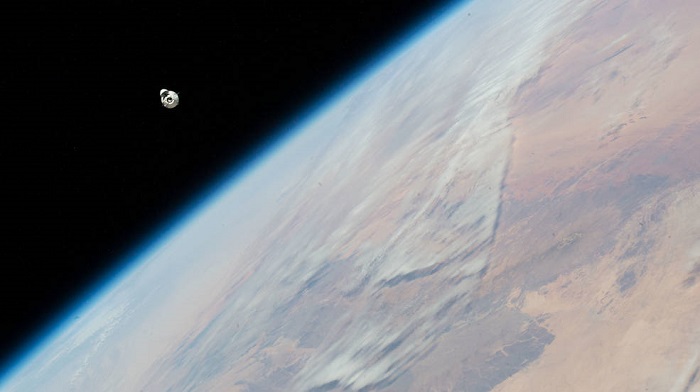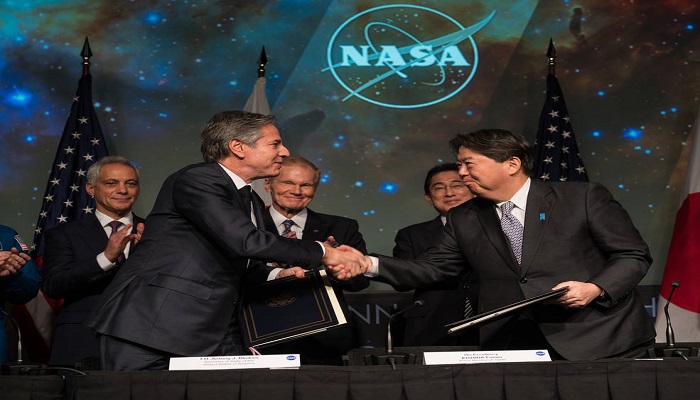ESA’s Jupiter Icy Moons Explorer (Juice) lifted off on an Ariane 5 rocket from Europe’s Spaceport in French Guiana at 14:14 CEST to discover secrets of Jupiter’s icy moons. The successful launch marks the beginning of an ambitious voyage to uncover the secrets of the ocean worlds around giant planet Jupiter.
Following launch and separation from the rocket, ESA’s European Space Operations Centre (ESOC) in Darmstadt, Germany, confirmed acquisition of signal via the New Norcia ground station in Australia at 15:04 CEST . The spacecraft’s 27 m long solar arrays unfurled into their distinctive cross shapes at 15:33 CEST, ensuring Juice can travel to the outer Solar System.
“ESA, with its international partners, is on its way to Jupiter,” says ESA Director General Josef Aschbacher. “Juice’s spectacular launch carries with it the vision and ambition of those who conceived the mission decades ago, the skill and passion of everyone who has built this incredible machine, the drive of our flight operations team, and the curiosity of the global science community. Together, we will keep pushing the boundaries of science and exploration in order to answer humankind’s biggest questions.”
“It is thanks to the leadership of ESA and the effort and commitment of hundreds of European industries and scientific institutions that the Juice mission has become a reality,” says Giuseppe Sarri, ESA’ s Juice Project Manager. “Together with our partners NASA, the Japan Aerospace Exploration Agency and the Israel Space Agency, who have also contributed hardware or scientific instrumentation, we have reached this much-awaited launch milestone.”
From Galileo to Juice
Jupiter, shining brightly in the night sky, has sparked fascination ever since our ancient ancestors first looked up. Astronomer Galileo Galilei brought Jupiter into focus in 1610, observing the planet through a telescope for the first time and discovering its orbiting moons.
Thanks to the legacy of previous Jupiter missions we know that three of the planet’s largest moons – Europa, Ganymede and Callisto – hold quantities of water buried under their surfaces in volumes far greater than in Earth’s oceans. These planet-sized moons offer us tantalising hints that conditions for life could exist other than here on our ‘pale blue dot’, and Juice is equipped to bring us one step closer to answering this alluring question.
“Today, we have sent a suite of ground-breaking science instruments on a journey to Jupiter’s moons that will give us an exquisite close-up view that would have been unimaginable to previous generations,” says Carole Mundell, ESA’s Director of Science.
“The treasure trove of data that ESA Juice will provide will enable the science community worldwide to dig in and uncover the mysteries of the jovian system, explore the nature and habitability of oceans on other worlds and answer questions yet unasked by future generations of scientists.”
Explore farther
Juice is the last ESA space science mission to launch on an Ariane 5, in a long legacy dating back to 1999.
“What a magnificent demonstration of Europe’s capacity to dream big and deliver results to match,” says Daniel Neuenschwander, ESA’s Director of Space Transportation. “We can all be proud of Ariane 5 for making possible missions like Juice and setting such a high standard for our new generation of launch systems.”
Over the next two-and-half weeks Juice will deploy its various antennas and instrument booms that will study the environment of Jupiter and the subsurface of the icy moons.
An eight-year cruise with four gravity-assist flybys at Earth and Venus will slingshot the spacecraft towards the outer Solar System.
“Hundreds of millions of kilometres from Earth and powered by just a sliver of sunlight, we will guide Juice through 35 flybys of Jupiter’s ocean moons in order to gather the data needed to bring scientists closer than ever to these compelling destinations,” says Ignacio Tanco, ESA’s Juice spacecraft operations manager.
To fly such a complex path from such an enormous distance – and vitally, to get Juice’s valuable data home to Earth – will require precise navigation techniques, reliant on ESA’s deep space antennas in Spain, Argentina and Australia, all controlled remotely from ESOC.
“The scientific treasure that will be returned will undoubtedly have far-reaching implications on how we understand our Solar System and if there are potentially habitable locations beyond Earth – not just in our own cosmic neighbourhood but also well beyond in the vast number of exoplanet systems populating our Universe,” says Olivier Witasse, ESA’s Juice project scientist. “In turn, this knowledge will make us richer beings, learning more about ourselves, our origins, and our place in the Universe.”
Source: ESA



